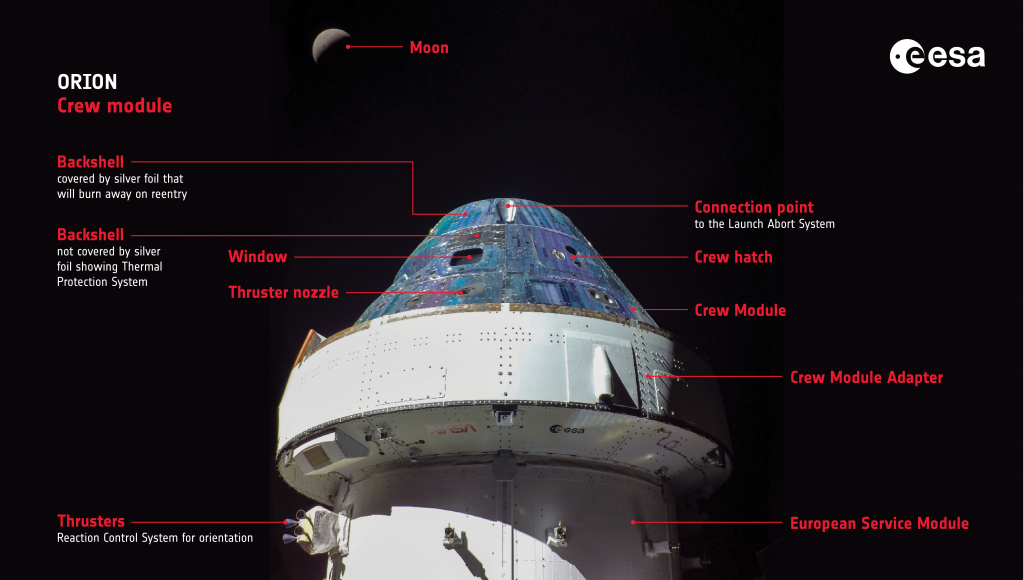On flight day 23, 8 December, of NASA’s Artemis I mission, Orion and its European Service Module continue making their trip to Earth, capturing photos and video along the way.
“At present, we are on track to have a fully successful mission with some bonus objectives that we’ve achieved along the way,” said Mike Sarafin, Artemis I mission manager. “On entry day, we will realise our priority one objective, which is to demonstrate the vehicle at lunar re-entry conditions, as well as our priority three objective, which is to retrieve the spacecraft.”
The mission management team met with the entry flight director and NASA recovery director to discuss the planned splashdown of Orion on 11 December. Considering weather predictions the team decided to target a splashdown in the Pacific Ocean near Isla Guadalupe, south of the primary landing area (not to be confused with the larger islands of Guadeloupe that are in the Atlantic Ocean, many kilometres away) .

Flight controllers conducted a final survey of Orion’s crew module and service module using cameras on each of the spacecraft’s four solar arrays. During the crew module inspection, flight controllers looked at the back shell made up of 1300 thermal protection system tiles that protect the crew capsule from the cold of space and the extreme heat of reentry.
Separation, farewell and splashdown
Just before reentry, the crew module and European Service Module will separate and only the crew module will return to Earth while the European Service Module burns up harmlessly in the atmosphere over the Pacific Ocean. The Artemis I trajectory is designed to ensure any remaining parts do not pose a hazard to land, people, or shipping lanes.

After separating from the European Service Module including the Crew Module Adapter, the crew module will prepare to perform a skip-entry technique to accurately splash down at the landing site. Orion will dip into the upper part of Earth’s atmosphere and use that atmosphere, along with the lift of the capsule, to skip back out of the atmosphere, then reenter for final descent under parachutes and splash down, similar to a final skip of a stone on water. This technique will allow for safe reentries on future Artemis missions regardless of when and where they return from the Moon.
Earth’s atmosphere initially will slow the spacecraft to 523 km/h from its intense approach velocity of 25 times faster than the speed of sound! Parachutes will slow Orion to a splashdown speed in about 10 minutes as it descends through Earth’s atmosphere. The passengers onboard, including Moonikin Campos, radiation phantoms Helga and Zohar, Snoopy and Shaun the Sheep will experience about four times the force of gravity, similar to an International Space Station reentry.
Parachute deployment begins at an altitude of about 8 km with three small parachutes pulling the forward bay covers away. Once the forward bay cover separates, two drogue parachutes will slow and stabilize the crew module for main parachute deployment. At an altitude just under 3 km the crew capsule will have slowed down to 209 km/h, and three pilot parachutes will lift and deploy the main parachutes. The 35-m parachutes are made of nylon and will slow the Orion crew module to its splashdown speed of 32 km/h or less.
The parachute system includes 11 parachutes attached to h with more than 21 km of Kevlar lines that are deployed in series using cannon-like mortars, pyrotechnic thrusters and bolt cutters.
Watch the coverage of Artemis I’s return to Earth from 17:00 CET (16:00 GMT) on 11 December via ESA television. The Orion spacecraft is scheduled separate from the European Service Module at 18:00 CET (17:00 GMT) with splashdown in the Pacific Ocean at 18:40 CET (17:40 GMT).
Just before 01:00 CET (00:00 GMT) on 9 December Orion was traveling 333 456 km from Earth and 290 325 km from the Moon, cruising at 2277 km/h.

 Automated Transfer Vehicle page
Automated Transfer Vehicle page ATV blog archive
ATV blog archive
 NASA Orion page
NASA Orion page NASA Artemis
NASA Artemis Airbus Orion page
Airbus Orion page
Discussion: 3 comments
Has the kind of skip-entry you described above ever been performed before?
Yes, the Soviet Zond lunar spacecraft used this reentry technique as they wanted to land in the USSR and without skipped entry it is impossible to reach what was the Soviet Union latitudes from a return from the Moon. The Chinese Chang’e 5 lunar sample return mission also did a skip on reentry.
thnx for this informative Blog